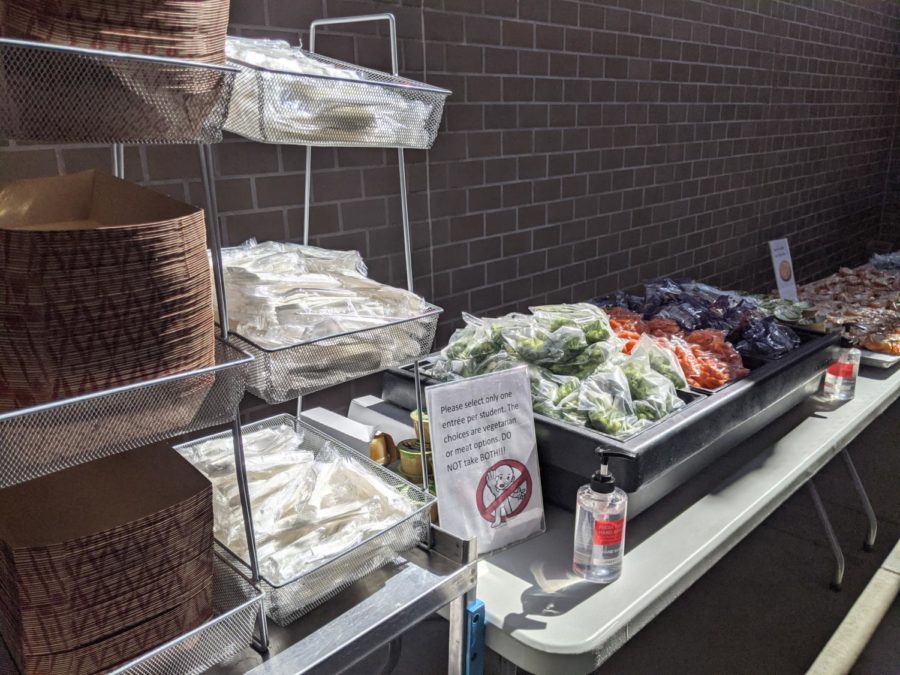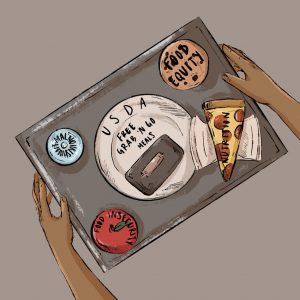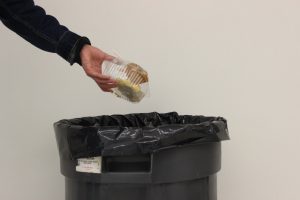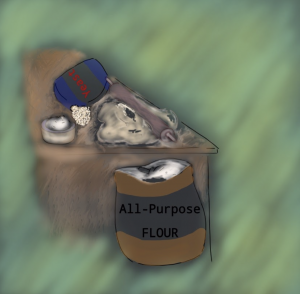Shortages eat away at California’s free lunch program in DVHS
Staff shortages, among other issues, prevent smooth rollout of the already restricted food form being distributed.
November 10, 2021
At DVHS, challenges of shortages, from staff to supply, along with COVID safety protocol are hampering the variety and quality of meal options in the new district free lunch plan.
California’s free lunch program, established in June 2021, has $54 million in state funding this year and aims to feed all 6.2 million California public school students free meals everyday. According to a report by the Associated Press, the goal is to “prevent the stigma of accepting free lunches and feed more hungry children,” not just those who qualify for federal assistance.
The California Department of Education estimated a 30-60% increase in lunch purchases with the onset of the program in a statement about the Nutrition Program.
“We used to do maybe 700-800 meals a day, and that number has jumped to almost 2,000 per day,” DVHS Child Nutrition Site Manager Stephanie Curry said.
Based on federal requirements for student nutrition, the district’s nutritional analyst creates menus for each student age group (elementary, middle, high school). These menus are then used by nutrition site managers to order meals from distributors each week and distributed to individual schools depending on the lunch needs of the student population.
However, before meals can be consumed by students, there are a few issues at each step of the distribution process — starting with manufacturers.
Because of the unpredictable supply line during virtual learning, meal manufacturers shifted their business focus to retail, grocery, healthcare and other sectors. And with the transition back to school, school meal production is not increasing to match the rise in the number of students consuming the food (from 5-10% to 80-90%). As a result, weekly orders from distributors are taking much longer to place and process, forcing school districts to ration food.
“Anybody that’s not in the industry or [doesn’t] see it firsthand just doesn’t know the severity of the strain in the supply chain, and how it’s such a trickle down effect,” said Peter Woods, regional sales manager of Gold Star Foods, the company which distributes food to SRVUSD.
According to Woods, lead times (amount of time between product order and fulfillment) have gone from seven to 35 days, which was “unheard of” during pre-pandemic school foodservice. Schools simply don’t have a choice to provide variety in their meal plans because they have to work with fewer food options over a long timeframe.
Even if schools are able to order the proper meals, the materials necessary for providing and transporting food are facing shortages as well. From foam trays distributed along with food to rubber for food truck tires, the scarcity of these items are preventing food from reaching schools and students.
“Where an average cost of a foam tray is maybe four or five cents, paper or some other material is eight cents to 12 cents,” Woods explained. “It’s very expensive … there are distributors across the country that are giving 30 to 60 days notice of cancellation to school districts that they’re just dropping them.”
Food safety requirements are also a factor in the lack of meal choices. Pre-pandemic, DVHS offered about 12 options for the main meal on a daily basis for school lunch, including multiple types of salads, hamburgers, etc. This was possible because most meals were cooked from scratch, Curry explains.
However, the pandemic, coupled with an explosion in the number of meals demanded, made scratch cooking unfeasible. Pre-packaged food from distributors is reheated and laid out in speed lines to maximize efficiency and safety, Curry furthered. This has limited the variety of meal options to solely items available from the food distributor.
Due to this shift, vegetarian options are especially limited. Many vegetarian meals need to be prepared fresh, so the lack of scratch cooking and food items available disproportionately impacts vegetarian options. Additionally, the list of USDA-approved vegetarian items is narrow, further complicating the issue of restricted vegetarian variety.
“There’s a quote requirement around protein, and historically that’s been met with animal-based protein or beans and legumes, there haven’t really been a lot of plant based proteins that were approved,” Zetta Reicker, director of child nutrition & warehouse at SRVUSD, said. “There’s a very specific Food Buying Guide that’s approved by the USDA, and unless an item is listed in the Food Buying Guide, we’re not allowed to have it. So it’s been very restrictive in terms of a lot of items that the community would want to have.”
Hand-in-hand with the food preparation issue is staff shortages. According to Reicker, DVHS needs at least eleven nutritional staff members that distribute food on site but currently only has seven.
“We’re serving more than twice the number of students, and we have less staff than we’ve ever had,” Reicker said. “We were serving 360 students before. Right now we’re averaging 1500 students a day, and we’re serving it in 15 minutes with four or five staff. It’s a phenomenal feat.”
As a result, the school does not have enough hands to carry out scratch cooking on the scale needed to feed all students, which is another reason why prepackaged meals are being served instead.
Junior Kajol Prasad, who eats the school lunches nearly every day, doesn’t feel satisfied with the quality of the prepackaged meals.
“The quality is pretty questionable,” Prasad said. For example, many of the less satisfying lunches contain cheese that doesn’t appear or taste fresh, she explained.
Despite the difficulties DVHS faces with the free lunch program, Reicker believes the issues are temporary and can be resolved if everyone in the community works together.
One of Reicker’s long-term goals is to host input workshops with the district community, where students and parents will be invited to share their thoughts on how the quality distribution and other aspects of school meals can be improved.
Zetta also shared the prospect of having students input their opinions on school lunches through an online form as she believes it is important to see how students would like to improve the school lunches.
“It is more than just designing the menu, it’s thinking about what kind of connection you are wanting to have with your food,” she said.
Past workshops with schools in Walnut Creek and San Francisco have been productive and shown promise for replication elsewhere, she explained. For example, the Walnut Creek workshop resulted in plans to carry out student and parent taste-testing of menu items to ensure food quality. It also contributed to expansion efforts of vegetarian and culturally-diverse meal options.
There are currently plans in place to begin student workshops during the spring semester of 2022.
“I’m excited to hear what the San Ramon Valley students are interested in; we can tailor the program according to what you all need,” Reicker said.
In terms of staff shortages, the district is “working creatively” to recruit more workers, Reicker said.
One plan in the works is a district-run series of Zoom sessions resembling a virtual job fair to encourage more people to apply to the various positions open at different school sites, which include more than just child nutrition-related jobs. Custodians and bus drivers are among the other staff needed in SRVUSD.
As for students, Reicker has a way for them to help out too: participate in the program.
“The more meals that we can claim for reimbursement, the more money we get. We’ll turn that money back into the program, and it will become better, but it will take time,” she said.








